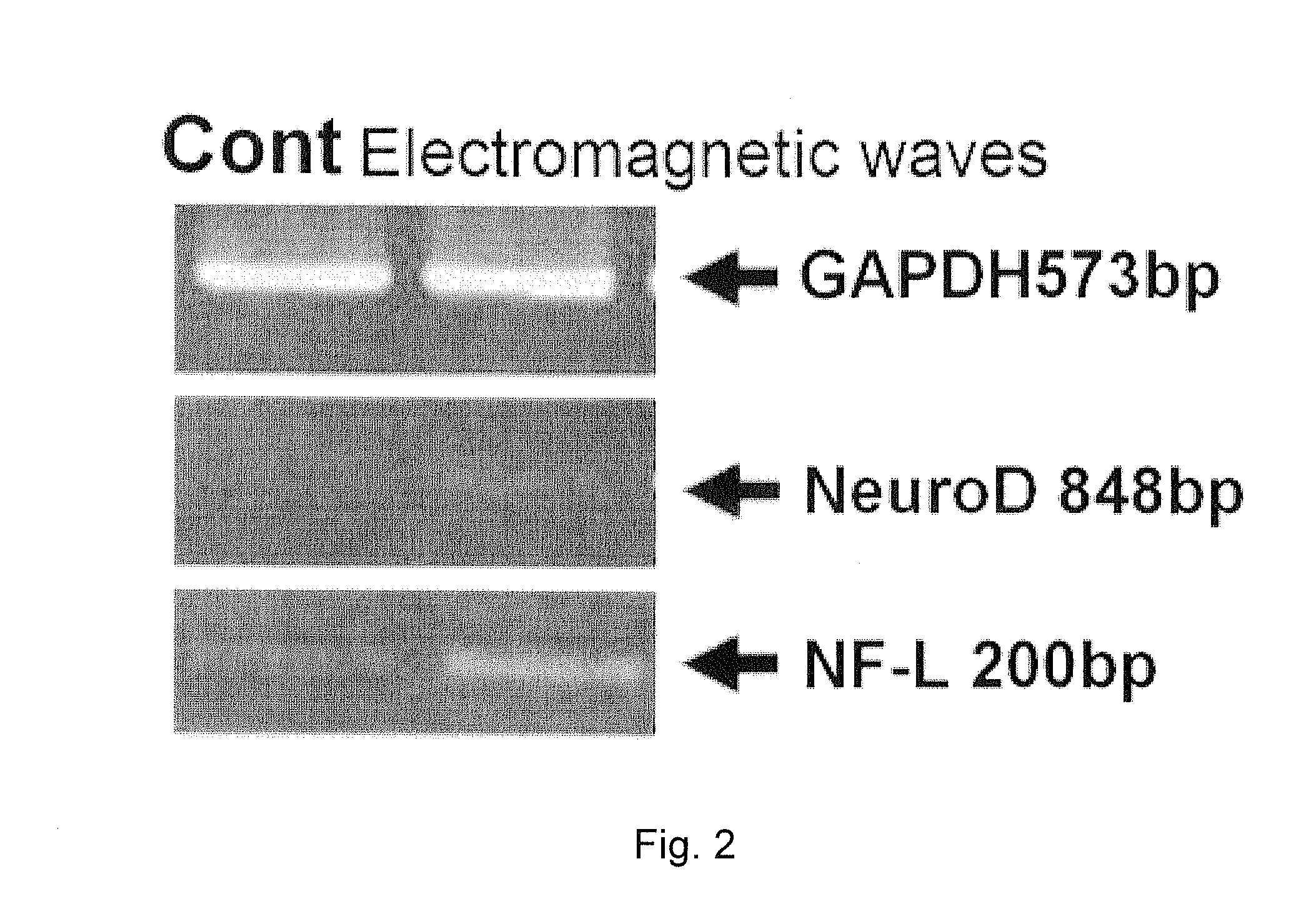Method for inducing differentiation of adult stem cells and nerve cells using electromagnetic field
a technology of electromagnetic field and stem cells, applied in the field of differentiation of mesenchymal stem cells or adult stem cells, can solve the problems of insufficient amount of human neural cells or neural precursor cells used in mixed culture, inability to obtain neural cells or neural stem cells, and inability to effectively use the virus, etc., to achieve the effect of easy neural cell acquisition and effective us
- Summary
- Abstract
- Description
- Claims
- Application Information
AI Technical Summary
Benefits of technology
Problems solved by technology
Method used
Image
Examples
reference example 1
Isolation of Umbilical Cord-Derived Mesenchymal Stem Cells and Culture of Bone Marrow and Adipose Derived Mesenchymal Stem Cells
[0052]Human umbilical cord expelled during childbirth was washed with phosphate buffer solution 3 times, and Wharton's jelly left after removal of smooth muscle and epithelium around blood vessels was cut into 3 mm×3 mm, placed in a culture vessel, and left in an incubator at 37° C. for about 4 hours such that the tissues were attached to the bottom of the vessel. When Dulbecco's Modification of Eagle's Medium (DMEM) containing 10% fetal bovine serum (FBS) was added to the culture vessel and cultured for 1 week, cells were isolated from the Wharton's jelly of the umbilical cord, and when more than 80% of cells were proliferated on the bottom of the culture vessel, the subculture was performed to use the subcultured cells as a cell source.
[0053]Mesenchymal stem cells (passage 2) from bone marrow were purchased from Lonza (Lonza, Walkersville, Md., USA) and m...
reference example 2
Primary Culture of Dental Pulp Cells
[0054]Human tooth extracted by surgical operation was placed in 20 ml of α-MEM medium (Welgene, Korea) containing 200 μl of antibiotic / antimycotic and 10 μl of gentamycin, stored in an ice box containing ice, and sent to the laboratory.
[0055]Dental pulp tissues were obtained from the tooth after incision and placed in 3 ml of 1500 U collagenase solution containing 1% (v / v) serum. The resulting solution was stirred in a CO2 incubator maintained at 37° C. for 90 minutes to loosen cells and tissues. Then, all tissues and enzymes were collected, placed in 20 ml of a-MEM medium containing 10% FBS, pipetted about 30 times, and then centrifuged at 800 rpm for 5 minutes. The supernatant was discarded and the remaining cells were inoculated into a 100 mm dish containing 10 ml of a-MEM medium containing 10% (v / v) FBS and cultured in a CO2 incubator maintained at 37° C. for 10 days, while replacing the medium every 3 days.
example 1
Capacity to Induce Differentiation of Mesenchymal Stem Cells into Neural Cells Using 50 to 200 Hz Electromagnetic Waves at Flux Density of 1 mT
[0056]This example relates to a method for inducing differentiation of mesenchymal stem cells into neural cells using electromagnetic fields, and this method can induce neuronal differentiation even under growth medium conditions. The capacity of differentiation of mesenchymal stem cells was maintained using nonhematopoietic stem cell media. Bone marrow-derived mesenchymal stem cells used in the experiment were obtained from Lonza, fat-derived mesenchymal stem cells were obtained from Invitrogen, and umbilical cord-derived mesenchymal stem cells were isolated according to the method described in Reference Example 1. All stem cells were cultured at 37° C. and 5% carbon dioxide atmosphere.
[0057]50 Hz electromagnetic waves at 1 mT were exposed to the mesenchymal stem cells for 7 days and immunohistochemically stained to observe the results. As c...
PUM
 Login to View More
Login to View More Abstract
Description
Claims
Application Information
 Login to View More
Login to View More - R&D
- Intellectual Property
- Life Sciences
- Materials
- Tech Scout
- Unparalleled Data Quality
- Higher Quality Content
- 60% Fewer Hallucinations
Browse by: Latest US Patents, China's latest patents, Technical Efficacy Thesaurus, Application Domain, Technology Topic, Popular Technical Reports.
© 2025 PatSnap. All rights reserved.Legal|Privacy policy|Modern Slavery Act Transparency Statement|Sitemap|About US| Contact US: help@patsnap.com



